In December 2016, visiting locomotive 30120 (the preserved Drummond 'T9') worked the 'Classic' train and 'Cumbria' (Hunslet 3794 'Austerity Tank'), hauled the 4-coach 'De Luxe' train. Jan was rostered as the driver of 'Cumbria' on Sunday 11th December and Sunday 18th December.
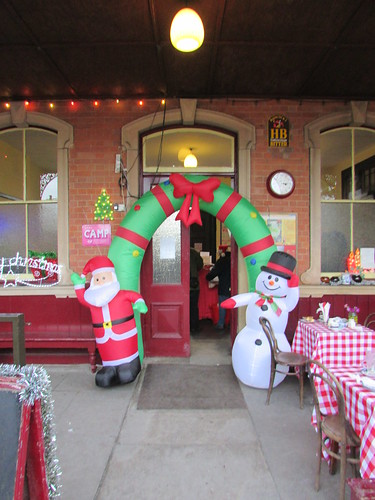 Shackerstone Station had festive decorations.
Shackerstone Station had festive decorations.
Events of Sunday 11th December 2016
It was still dark when I arrived at Shackerstone shed but Steve, who was firing 'Cumbria', had just started work and Dave and Carl on the 'T9' had matters well in hand for their earlier departure with the first 'Classic' train of the day. Whilst Steve cleaned the grate and laid the fire, I started oiling-round. By the time I'd finished, 'Cumbria', still warm from the previous day, was just starting to make steam. Once the 'T9' had left the shed, the inspection pit in the shed became available and in due course we moved 'Cumbria' onto the pit so that Steve could clear the ash from the ashpan. I noticed that the rear damper door was reluctant to latch in the 'open' position and Steve had to wedge the damper door open using a spare ashpan rake. Whilst we were over the pit, I completed my examination of the underside of the locomotive. This included checking the six underhung springs, spring hangers and associated fixings, the cylinder drain cocks and operating levers, the brake rigging, steam brake cylinder, handbrake screw and associated linkages, the base of the firebox, the firegrate and foundation ring, the ashpan, in fact generally looking for trouble or what might develop into trouble. Meanwhile, a hose pipe attached to the mains water supply was slowly filling the saddle tank.
As the boiler pressure increased, we moved the locomotive outside the shed and did as much cleaning as time permitted before coming 'off shed' via the ground frame and coupling up to our 4-coach train waiting in platform 1 so that we could start steam heating the train.
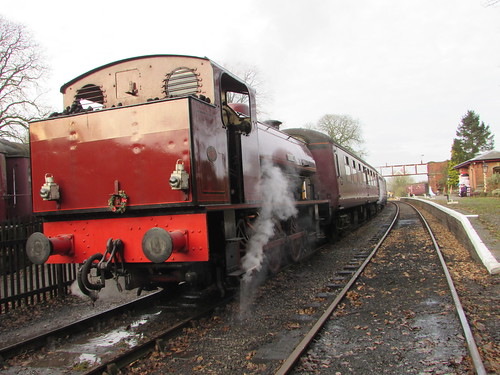
Shackerstone Santa Specials: 'Cumbria' steam heating the stock for the 'De-Luxe' train.
Our first departure was a little delayed (Santa cannot be hurried so the 'Classic' train, hauled by the 'T9', was a little late arriving back at Shackerstone). Once we did set off, it was at a rather pedestrian pace as Santa slowly worked his way from compartment to compartment greeting our young visitors. We stopped at Market Bosworth for a while to let Santa get a little further along the train and then continued, at a similar slow speed, to our terminus at Shenton. Steve and I then ran 'Cumbria' round the train and re-coupled, ready for our return to Shackerstone, this time chimney leading. Santa was still distributing presents so we trundled back to Market Bosworth at the usual slow speed, making us lose more time. However, after waiting at Market Bosworth for a few minutes, Santa had finished seeing all the children and so we were told that we could make our return to Shackerstone at 'Line Speed' (a fairly modest 25 m.p.h. with certain sections at lower speed).
Once we'd brought our train back into platform 1 at Shackerstone, the 'T9' was able to depart with the delayed second 'Classic' train of the day. This left platform 2 free for us the run round our train, stopping to water at the water column. That was when the plan unravelled. Steve man-handled the water 'bag' into the tank filler and I opened the water valve (a big, horizontal wheel which for some reason is turned clockwise to allow water to flow, unlike most water taps). At first, water started to flow but Steve quickly realised that the volume was reducing to a trickle. He climbed down to the ground and went to investigate the problem.
Locomotive Water Supplies
In addition to needing fuel to generate heat, steam locomotives require copious supplies of water which is boiled, used to push a piston down a cylinder to produce motion and then (unless we're talking about compound or condensing designs) immediately discharged as exhaust steam. I discussed carrying water on locomotives in the post Water, water, everywhere. So the first thing locomotives run out of is usually water (followed by either fuel or a sufficiently energetic fireman to continue working). A hose connected to a mains water supply may suffice on shed whilst an engine is being brought into steam but, once on the road, the locomotive needs to be replenished in a matter of minutes so normally large, elevated tanks are required at strategic locations along the railway which can be refilled from a more modest water main over a period of time and rapidly discharged by gravity through a large capacity pipe into the locomotive's water tank. Various sizes and arrangements for the elevated tanks could be found in the steam era.
A common British arrangement was to mount the tank on a brick structure. The picture below shows a fairly grand preserved example adjacent to Huddersfield Station (for a little more about this splendid survivor, see the post Day Trip to Shipley).
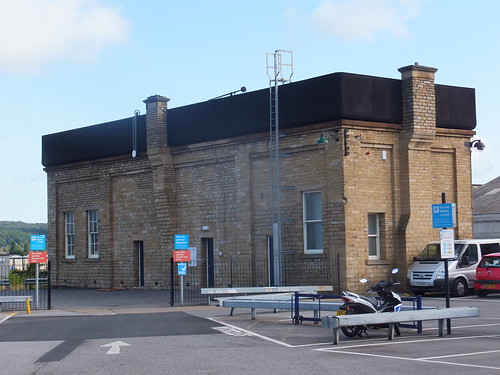
Railway water tower at Huddersfield Station.
Alternately, the tank could be supported on a metal framework.
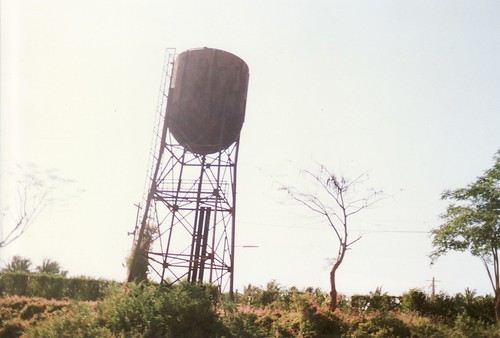
A large railway water tower in Thailand.
In the Parachute Tank design, a round metal tank was balanced on top of a cast column at the point of use but, more commonly, the water column (or water crane) at the trackside would be fed by a high-capacity pipe from a remote tank. When I was young, I used to watch locomotives taking water at Wolverhampton High Level Station and the LNWR pattern water column in use there is described in the section 'Water Column' in post Wolverhampton High Level Remembered.
Arrangements at Shackerstone
There are two, interconnected tanks, elevated by being positioned at the top of the bank adjacent to the railway. These are normally filled under the control of a float valve from the available public water supply and a high capacity pipe feeds water to the water crane at the end of platform 2.
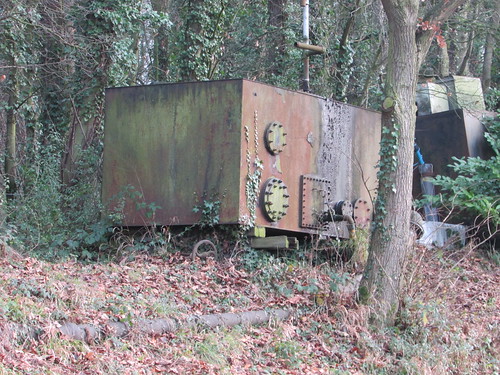 Shackerstone: The tanks for the locomotive water supply on the bank adjacent to platform 2.
Shackerstone: The tanks for the locomotive water supply on the bank adjacent to platform 2.

Shackerstone: The Water Crane at the end of platform 2.
The Problem
Steve quickly diagnosed the problem. Because of a fault on the float valve, the stop valve in the incoming water supply had been shut to prevent possible overflow but had not been re-opened, allowing the tank to empty itself. Opening the stop valve allowed water to start flowing into the tank but it would be some hours before a proper supply was available. The platform tracks at Shackerstone are provided with hoses connected to the mains for refilling the lavatory tanks on the passenger coaches and we experimented with taking water from here, but it was clear that we would not have taken sufficient water in time to work our next booked 'De-Luxe' service ('Cumbria' uses rather a lot of water, especially when carriage warming is required).
The Solution
The 'T9', on its way back from Shenton after its second trip with the 'Classic' train, had sufficient water for another trip (it's paired with an 8-wheel 'Watercart' tender) so it was decided to 'swop' the engines, with the 'T9' taking the second 'De-Luxe' train, giving 'Cumbria' another hour or so to finish watering from the mains supply before taking the last 'Classic' train.
The returning 'Classic' train was stopped just short of the signal box and the 'T9' uncoupled and moved forward, light engine, to couple onto the 'De-Luxe' train in platform 1. As soon as the 'T9' had cleared the crossover, we moved towards the coaches of the 'Classic' service, coupled on, and brought the train into platform 2 so that the passengers could disembark. If any of the passengers noticed that they'd left Shenton with one engine and arrived at Shackerstone with a different engine, they made no comment!
Once the 'T9' had departed with the 'De-Luxe' train, we were able to run round the coaches of the 'Classic' train and provide steam heat whilst we continued to slowly replenish our saddle tank. By the time the 'T9' returned, it was becoming dark so Steve had lit our engine lamps. We also had a full tank of water. Once we had the 'Right Away' from the Guard, we set off in the gathering gloom at the accustomed gentle pace for 'Santa' trains. On arrival at Shenton, we cautiously ran round the train - everything becomes harder in the dark - and waited for the 'tip' from the Guard.
We were told that Santa had completed his present distribution, so we could return at 'Line Speed', although a stop at Market Bosworth was required to allow some people off the train, so we had an enjoyable trip back to Shackerstone and, approaching the signal box found the 'Bottom Dolly' disc signal 'off' for platform 2, as expected. The 'T9' had run round the 'De-Luxe' stock to the Shenton end of the train. We uncoupled from the 'Classic' train and, by the time we'd moved the engine down to the 'North End', the 'T9' had drawn the 'De-Luxe' stock 'Up the Cutting', leaving platform 1 clear for us to pass through the platform to the Ground Frame and go 'on shed'. We 'tied-down' 'Cumbria' well inside the shed and completed our disposal. Meanwhile, the 'T9' pushed the 'De-Luxe' stock back into platform 1, uncoupled and followed us onto shed. Well, we were about 30 minutes late finishing the 'Santa' trains but, considering the difficulties, we thought that not a bad result. There were certainly lots of pleased passengers during the day.
Events of Sunday 18th December 2016
It was still dark when I arrived, a little before 7.00 a.m. John B. and Sam B. had arrived and were preparing the 'T9'. The good news was that, during the previous week Steve had repaired the faulty float valve on the locomotive water supply which had caused problems during my previous 'turn'. The bad news was that there was no fireman for 'Cumbria' and that I was on my own. It appeared that, unless I set to and tackled both fireman's and driver's duties (at least temporarily), a number of disappointed visitors were guaranteed. I couldn't find a firing shovel (not a good start) but I borrowed the 'spare' shovel off the 'T9'. I couldn't find wood for lighting-up. Sam said he'd had a similar problem but showed me a rather damp wooden panel which he'd been breaking up to use on the 'T9' and he helped me break up a bit more of the panel.
Lighting-up
Before lighting-up, the safety of the boiler must be assessed. The two gauge glasses had been, correctly, left isolated overnight so I 'opened' them, 'blew-down' (actually 'drained-down' since there was no pressure left in the boiler) and satisfied myself, by comparison of the levels in the glasses, that there was adequate water in the boiler. Then, I checked around the boiler for leaks. Mudholes, washout plugs, stays, rivets, foundation ring, boiler tubes and fusible plug should all be examined. The firegrate still had the now-cold ash and clinker from the previous day's fire so, armed with a suitable fireiron (a substantial 'straight dart' about five feet in length), I slid the end of the dart forwards and backwards along the firebars to encourage the remains to drop through the air spaces into the ashpan. This is a fairly energetic process which, of course, produces clouds of dust. Any large clinker has to be extracted with the clinker shovel ('paddle') through the firehole door but, being short of time, I managed to avoid this by 'bashing' larger pieces with the dart to break them up. The cleaner the firegrate before setting a new fire, the less likely are subsequent steaming problems but, in the circumstances, I settled for a result a little short of the proverbial "clean enough to eat your dinner off".
There are nearly as many methods of steam-raising as there are fireman. I adopted a method that's worked well on a wide range of locomotives. First, I shovelled a thin bed of coal across most of the firegate. I selected a fairly thin stick of wood from my meagre supply, wrapped it in a oil-soaked rag and lit the rag from a match. I carefully dropped the burning stick onto the grate and added more wood, attempting to form a "Scout's Campfire" shape so that each piece of wood could be exposed to the heat but also have plenty of air around it. I added a little oil to encourage the damp wood to burn and was gratified to see a reasonable wood fire result. Next, I tossed some small pieces of coal onto the wood so that the coal would be warmed. Worried that the wood would expire before the coal caught alight, I returned to the remains of the damp wooden panel and broke up a little more wood which I added to the fire with more selected pieces of coal. I then applied the "Ten Minute Rule" - open the dampers, close the firedoors and do something else for ten minutes. Well, I'd plenty of other things to do with an engine to examine and oil. After ten minutes, the fire had 'caught' better than I dared hope, so I applied a light firing of coal, making sure that there was coal around the edges of the burning mass to encourage the fire to spread across the firegrate and then left it for another ten minutes. Some fireman tend to 'black-out' the fire and leave it for half-an-hour or more, later spreading the fire around the grate with a fireiron but I've found that following the "Ten Minute Rule" will warm an engine faster but gently and (except on very large firegrates) avoids the need to use a fireiron to spread the fire altogether. An engine is immobile until it's producing steam and, with around half a ton of water in the boiler of an 'Austerity', it takes time and a decent fire to bring it to the boil, even when the water is warm from the previous day.
Of course, being on my own there was a lot of climbing up and down involved - hose into the tank to take water, work progressively around the engine applying oil, return periodically to the footplate to fire. By the time the 'T9' moved off shed, 'Cumbria' was starting to make steam so I could consider moving onto the pit to empty the ashpan. Getting an engine to move is always the lesser problem - getting it to stop is the main safety consideration and when single-manning the risks are increased. With around 30 p.s.i. on the clock, I gingerly moved the engine onto the pit without incident. I clambered underneath 'Cumbria' with two ashpan rakes - one to rake out the ash, one to wedge the front ashpan door open. Perhaps unwisely, I decided to leave the hose feeding the locomotive's water tank, as I was anxious to start out with a full tank, and so I raked out the ashpan 'dry'. I eventually emerged from the pit, after shifting a fair amount of ash from the two ashpans, spluttering from the dust and white like a snowman. Simon P. chose this moment to appear and comment "You should be coming off shed now to steam heat the train". My rather terse response encouraged him to assist by checking the saddle tank water level (I decided we'd enough), operate the Ground Frame and, after I'd moved the engine onto the four coach 'De-Luxe' train, couple up.
In the section Related posts on this site below, various posts on steam-raising and preparation are linked.
The First 'De-Luxe' service
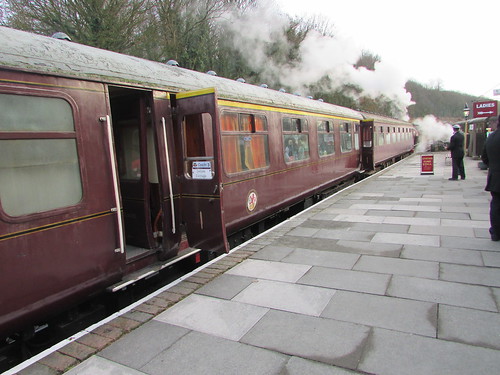
Shackerstone Santa Specials: 'Cumbria' (shrouded in steam) waiting to take the 'De-Luxe' train.
After my unexpected exertions getting 'Cumbria' ready, I was content to look after the engine whilst warming the train, maintaining the fire and keeping the boiler topped-up. But we would need a fireman if we were to take the 'De-Luxe' train down the line. Management decided that, when the 'T9' returned, Sam (who was firing the 'T9') would have to immediately swop onto 'Cumbria' and fire that trip. So that's what happened. We made a leisurely progress to Shenton, pausing a Market Bosworth, as 'Santa' made his way through the train. Sam and I ran round the train and were told that the return to Shackerstone could be made at normal speed, so we enjoyed a slightly more spirited run back. Sam then swopped back onto the 'T9' for another run to Shenton with the 'Classic' train.
The Second 'De-Luxe' service
Again, I was happy to 'baby-sit' the engine before our second journey to Shenton, expecting that Sam would have to swop engines again. But, having completed other duties, Martin S. appeared, saying the he would fire the second trip. As Santa dealt with his excited young visitors, we made our sedate way from Shackerstone to Shenton and ran round, ready for the return.

Shackerstone Santa Specials: View from footplate of 'Cumbria' looking back along the train between Market Bosworth and Shenton.
As it became dark, we were able to return to Shackerstone at normal speed because Santa had completed his rounds. As usual, we ran into platform 1, uncoupled and waited for the 'T9' to leave with the last train of the day. Whilst we waited, our passengers streamed past on their way to the car park - everybody seemed in good spirits.
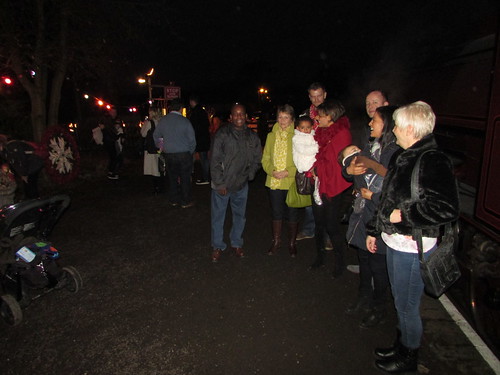
Shackerstone Santa Specials: Platform 1 North End. A group of happy passengers photographed with 'Cumbria' in the background.
After the 'T9' had left we were able to run round the train. Martin said that I could propel the empty stock to the North End, to stable overnight, and that he would act as Shunter. He released the Guard's handbrake and gave me handsignals with a 'Bardic' battery handlamp from the far end of the train. I eased the train forward very gently. In the dark, the driver is reliant on the Shunter's signals (although, noting the position of the locomotive, I could work out roughly where the other end of the stock would be). When the white "come towards" handsignal changed to steady red, I stopped the movement and waited for Martin to re-apply the Guard's Handbrake and walk back to uncouple 'Cumbria' from the coaches.
Then we were able to return, via Platform 1 and the Ground Frame, to the shed where we stabled well inside so that the 'T9' could come in after us and we completed our disposal.
Related posts on this site
Driving Turn at Peak Rail - Part One: Preparation
Preparation of Locomotive 'Sapper'
(Both of the above describe the preparation of locomotives similar to 'Cumbria' at another railway).
MIC - Firing Steam Locomotives (1).
The 'Austerity' 0-6-0ST locomotive.
There are a number of other posts about footplate work on 'Cumbria' on the Battlefield Line:-
'Santa Specials' at The Battlefield Line - Christmas 2015.
The Battlefield Line Steam Gala.
Sunday at Shackerstone.
'Operation: Market Bosworth' - On the Footplate.
Related posts on other sites
Sam Brandist has his own blog and has posted an interesting account of his day on the 'T9' (and helping me with 'Cumbria') on Sunday, 11th December. You can find his report here.
My Pictures
Shackerstone Santa Specials.
